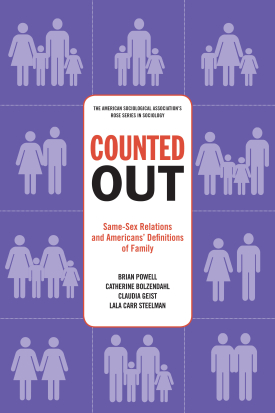
Counted Out
About This Book
A Volume in the American Sociological Association’s Rose Series in Sociology
Winner of the 2011 William T. Goode Award from the Family Section of the American Sociological Association
Winner of the North Central Sociological Association’s 2011 Scholarly Achievement Award
Winner of the Midwest Sociological Society’s 2011 Distinguished Book Award
When state voters passed the California Marriage Protection Act (Proposition 8) in 2008, it restricted the definition of marriage to a legal union between a man and a woman. The act’s passage further agitated an already roiling national debate about whether American notions of family could or should expand to include, for example, same-sex marriage, unmarried cohabitation, and gay adoption. But how do Americans really define family? The first study to explore this largely overlooked question, Counted Out examines currents in public opinion to assess their policy implications and predict how Americans’ definitions of family may change in the future.
Counted Out broadens the scope of previous studies by moving beyond efforts to understand how Americans view their own families to examine the way Americans characterize the concept of family in general. The book reports on and analyzes the results of the authors’ Constructing the Family Surveys (2003 and 2006), which asked more than 1,500 people to explain their stances on a broad range of issues, including gay marriage and adoption, single parenthood, the influence of biological and social factors in child development, religious ideology, and the legal rights of unmarried partners. Not surprisingly, the authors find that the standard bearer for public conceptions of family continues to be a married, heterosexual couple with children. More than half of Americans also consider same-sex couples with children as family, and from 2003 to 2006 the percentages of those who believe so increased significantly—up 6 percent for lesbian couples and 5 percent for gay couples. The presence of children in any living arrangement meets with a notable degree of public approval. Less than 30 percent of Americans view heterosexual cohabitating couples without children as family, while similar couples with children count as family for nearly 80 percent. Counted Out shows that for most Americans, however, the boundaries around what they define as family are becoming more malleable with time.
Counted Out demonstrates that American definitions of family are becoming more expansive. Who counts as family has far-reaching implications for policy, including health insurance coverage, end-of-life decisions, estate rights, and child custody. Public opinion matters. As lawmakers consider the future of family policy, they will want to consider the evolution in American opinion represented in this groundbreaking book.
BRIAN POWELL is Rudy Professor of Sociology at Indiana University.
CATHERINE BOLZENDAHL is assistant professor of sociology in the School of Social Sciences at the University of California, Irvine.
CLAUDIA GEIST is assistant professor in the Department of Sociology at the University of Utah.
LALA CARR STEELMAN is professor in the Department of Sociology at the University of South Carolina.
Related Events & Media
RSF Journal
View Book Series
Sign Up For Our Mailing List
Apply For Funding
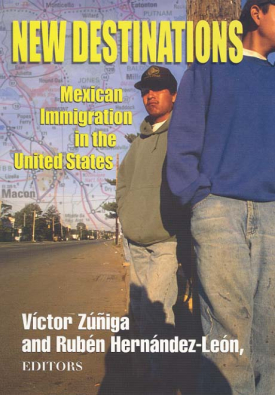
New Destinations
About This Book
Mexican immigration to the United States—the oldest and largest immigration movement to this country—is in the midst of a fundamental transformation. For decades, Mexican immigration was primarily a border phenomenon, confined to Southwestern states. But legal changes in the mid-1980s paved the way for Mexican migrants to settle in parts of America that had no previous exposure to people of Mexican heritage. In New Destinations, editors Víctor Zúñiga and Rubén Hernández-León bring together an inter-disciplinary team of scholars to examine demographic, social, cultural, and political changes in areas where the incorporation of Mexican migrants has deeply changed the preexisting ethnic landscape.
New Destinations looks at several of the communities where Mexican migrants are beginning to settle, and documents how the latest arrivals are reshaping—and being reshaped by—these new areas of settlement. Contributors Jorge Durand, Douglas Massey, and Chiara Capoferro use census data to diagram the historical evolution of Mexican immigration to the United States, noting the demographic, economic, and legal factors that led recent immigrants to move to areas where few of their predecessors had settled. Looking at two towns in Southern Louisiana, contributors Katharine Donato, Melissa Stainback, and Carl Bankston III reach a surprising conclusion: that documented immigrant workers did a poorer job of integrating into the local culture than their undocumented peers. They attribute this counterintuitive finding to documentation policies, which helped intensify employer control over migrants and undercut the formation of a stable migrant community among documented workers. Brian Rich and Marta Miranda detail an ambivalent mixture of paternalism and xenophobia by local residents toward migrants in Lexington, Kentucky. The new arrivals were welcomed for their strong work ethic so long as they stayed in “invisible” spheres such as fieldwork, but were resented once they began to take part in more public activities like schools or town meetings. New Destinations also provides some hopeful examples of progress in community relations. Several chapters, including Mark Grey and Anne Woodrick’s examination of a small Iowa town, point to the importance of dialogue and mediation in establishing amicable relations between ethnic groups in newly multi-cultural settings.
New Destinations is the first scholarly assessment of Mexican migrants’ experience in the Midwest, Northeast, and deep South—the latest settlement points for America’s largest immigrant group. Enriched by perspectives from demographers, anthropologists, sociologists, folklorists, and political scientists, this volume is an essential starting point for scholarship on the new Mexican migration.
VÍCTOR ZÚÑIGA is dean of the School of Education and Humanities at the Universidad de Monterrey.
RUBÉN HERNÁNDEZ-LEÓN is assistant professor of sociology at the University of California at Los Angeles.
CONTRIBUTORS: Ana Maria Aragones, Carl L. Bankston III, Chiara Capoferro, Miguel A. Carranza, Jasney Cogua, Katharine M. Donato, Timothy J. Dunn, Jorge Durand, Lourdes Gouveia, Mark A. Grey, David C. Griffith, Douglas S. Massey, Marta Miranda, Brian L. Rich, George Shivers, Debra Lattanzi Shutika, Robert Courtney Smith, Melissa Stainback, Anne C. Woodrick.
RSF Journal
View Book Series
Sign Up For Our Mailing List
Apply For Funding
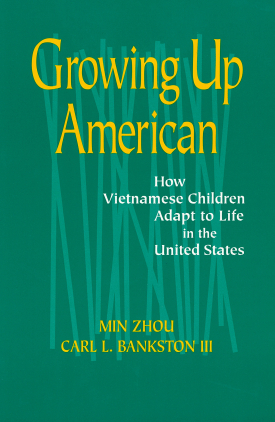
Growing Up American
About This Book
Winner of the 1999 Thomas and Znaniecki Award from the International Migration Section of the American Sociological Association
Vietnamese Americans form a unique segment of the new U.S. immigrant population. Uprooted from their homeland and often thrust into poor urban neighborhoods, these newcomers have nevertheless managed to establish strong communities in a short space of time. Most remarkably, their children often perform at high academic levels despite difficult circumstances. Growing Up American tells the story of Vietnamese children and sheds light on how they are negotiating the difficult passage into American society.
Min Zhou and Carl Bankston draw on research and insights from many sources, including the U.S. census, survey data, and their own observations and in-depth interviews. Focusing on the Versailles Village enclave in New Orleans, one of many newly established Vietnamese communities in the United States, the authors examine the complex skein of family, community, and school influences that shape these children's lives. With no ties to existing ethnic communities, Vietnamese refugees had little control over where they were settled and no economic or social networks to plug into. Growing Up American describes the process of building communities that were not simply transplants but distinctive outgrowths of the environment in which the Vietnamese found themselves. Family and social organizations re-formed in new ways, blending economic necessity with cultural tradition. These reconstructed communities create a particular form of social capital that helps disadvantaged families overcome the problems associated with poverty and ghettoization.
Outside these enclaves, Vietnamese children faced a daunting school experience due to language difficulties, racial inequality, deteriorating educational services, and exposure to an often adversarial youth subculture. How have the children of Vietnamese refugees managed to overcome these challenges? Growing Up American offers important evidence that community solidarity, cultural values, and a refugee sensibility have provided them with the resources needed to get ahead in American society. Zhou and Bankston also document the price exacted by the process of adaptation, as the struggle to define a personal identity and to decide what it means to be American sometimes leads children into conflict with their tight-knit communities.
Growing Up American is the first comprehensive study of the unique experiences of Vietnamese immigrant children. It sets the agenda for future research on second generation immigrants and their entry into American society.
MIN ZHOU is associate professor of sociology and Asian American studies at the University of California, Los Angeles.
CARL L. BANKSTON III is assistant professor of sociology at the University of Southwestern Louisiana.
RSF Journal
View Book Series
Sign Up For Our Mailing List
Apply For Funding
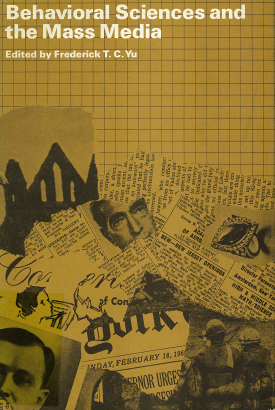
Behavioral Sciences and the Mass Media
About This Book
Presents papers which were discussed at the Arden House Conference—a conference held to establish a working relationship between sociologists at the Russell Sage Foundation and journalists of the Graduate School of Journalism of Columbia University. Both behavioral science and journalism have for a long time been concerned with some of the same major national social problems—juvenile delinquency, urban problems, race and minority group relations, international tensions, and labor relations. These papers touch on some of the barriers to communication and point to possible ways of breaking through those barriers.
FREDERICK T. C. YU is professor and director of research at the Graduate School of Journalism at Columbia University.
CONTRIBUTORS: Ben H. Bagdikian, Leo Bogart, Edgar F. Borgatta, Marvin Bressler, John Mack Carter, Wayne A. Danielson, W. Phillips Davison, Emmett Dedmon, Eli Ginzberg, Ernest Havemann, Herbert H. Hyman, Robert L. Jones, Alfred J. Kahn, Joseph T. Klapper, Melvin L. Kohn, Daniel Lerner, Ronald Lippitt, John W. Riley Jr., Earl Ubell, Richard C. Wald, Stanton Wheeler, Robin M. Williams Jr., and Frederick T. C. Yu
Download
RSF Journal
View Book Series
Sign Up For Our Mailing List
Apply For Funding
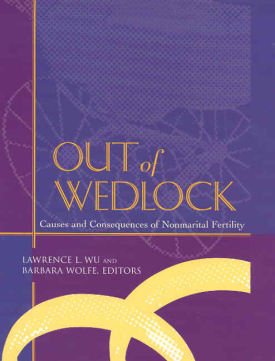
Out of Wedlock
About This Book
Today, one third of all American babies are born to unmarried mothers—a startling statistic that has prompted national concern about the consequences for women, children, and society. Indeed, the debate about welfare and the overhaul of the federal welfare program for single mothers was partially motivated by the desire to reduce out of wedlock births. Although the proportion of births to unwed mothers has stopped climbing for the first time since the 1960s, it has not decreased, and recent trends are too complex to attribute solely to policy interventions. What are these trends and how do they differ across groups? Are they peculiar to the United States, or rooted in more widespread social forces? Do children of unmarried mothers face greater life challenges, and if so what can be done to help them? Out of Wedlock investigates these questions, marshalling sociologists, demographers, and economists to review the state of current research and to provide both empirical information and critical analyses.
Out of Wedlock employs a wealth of data, including the age, race, education, and other life circumstances of unwed mothers, and draws telling comparisons with other industrialized nations. Other nations have also experienced sharp increases in nonmarital fertility, but their births largely occur among cohabiting couples. Unwed mothers in the United States tend to be younger, less educated, from minority backgrounds, and to be living separately from their child's father. These trends may help explain the high rate of childhood poverty in this country. Out of Wedlock also examines such issues as the role of child support in providing income to children born outside of marriage, as well as the social and emotional outcomes for children of unwed mothers from infancy through early adulthood.
The conflicting data on nonmarital fertility give rise to a host of vexing theoretical, methodological, and empirical issues, some of which researchers are only beginning to address. Out of Wedlock breaks important new ground, bringing clarity to the data and examining policies that may benefit these particularly vulnerable children.
LAWRENCE L. WU is professor of sociology at the University of Wisconsin, Madison.
BARBARA WOLFE is professor of economics, public affairs, and preventive medicine at the University of Wisconsin, Madison.
CONTRIBUTORS:
Judi Bartfeld, Larry Bumpass, Andrew Cherlin, John Ermisch, Deborah DeGrafe, Michael Foster, Irwin Garfinkel, Robert Haveman, Saul Hoffman, Theodore Joyce, Robert Kaestner, Kelleen Kaye, Kathleen Kiernan, Sanders Korenman, Daniel Lichter, Lee Lillard, Shelley Lundberg, Sara McLanahan, Daniel Meyer, Robert Moffitt, Kelly Musick, Constantijn Panis, Karen Pence, Nancy Reichman, Julien Teitler, Dawn Upchurch, Barbara Wolfe, Lawrence Wu
Download
RSF Journal
View Book Series
Sign Up For Our Mailing List
Apply For Funding
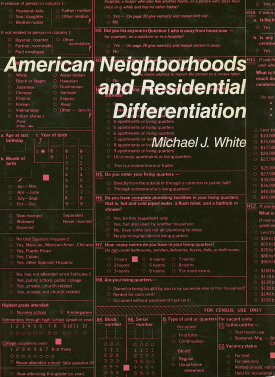
American Neighborhoods and Residential Differentiation
About This Book
Residential patterns are reflections of social structure; to ask, "who lives in which neighborhoods," is to explore a sorting-out process that is based largely on socioeconomic status, ethnicity, and life cycle characteristics.
This benchmark volume uses census data, with its uniquely detailed information on small geographic areas, to bring into focus the familiar yet often vague concept of neighborhood. Michael White examines nearly 6,000 census tracts (approximating neighborhoods) in twenty-one representative metropolitan areas, from Atlanta to Salt Lake City, Newark to San Diego. The availability of statistics spanning several decades and covering a wide range of demographic characteristics (including age, race, occupation, income, and housing quality) makes possible a rich analysis of the evolution and implications of differences among neighborhoods.
In this complex mosaic, White finds patterns and traces them over time—showing, for example, how racial segregation has declined modestly while socioeconomic segregation remains constant, and how population diffusion gradually affects neighborhood composition. His assessment of our urban settlement system also illuminates the social forces that shape contemporary city life and the troubling policy issues that plague it.
MICHAEL J. WHITE is at the Urban Institute.
A Volume in the RSF Census Series
Download
RSF Journal
View Book Series
Sign Up For Our Mailing List
Apply For Funding

Achieving Anew
About This Book
Winner of the 2010 Otis Dudley Duncan Award for Outstanding Scholarship in Social Demography
Can the recent influx of immigrants successfully enter the mainstream of American life, or will many of them fail to thrive and become part of a permanent underclass? Achieving Anew examines immigrant life in school, at work, and in communities and demonstrates that recent immigrants and their children do make substantial progress over time, both within and between generations.
From policymakers to private citizens, our national conversation on immigration has consistently questioned the country’s ability to absorb increasing numbers of foreign nationals—now nearly one million legal entrants per year. Using census data, longitudinal education surveys, and other data, Michael White and Jennifer Glick place their study of new immigrant achievement within a context of recent developments in assimilation theory and policies regulating who gets in and what happens to them upon arrival. They find that immigrant status itself is not an important predictor of educational achievement. First-generation immigrants arrive in the United States with less education than native-born Americans, but by the second and third generation, the children of immigrants are just as successful in school as native-born students with equivalent social and economic background. As with prior studies, the effects of socioeconomic background and family structure show through strongly. On education attainment, race and ethnicity have a strong impact on achievement initially, but less over time.
Looking at the labor force, White and Glick find no evidence to confirm the often-voiced worry that recent immigrants and their children are falling behind earlier arrivals. On the contrary, immigrants of more recent vintage tend to catch up to the occupational status of natives more quickly than in the past. Family background, educational preparation, and race/ethnicity all play a role in labor market success, just as they do for the native born, but the offspring of immigrants suffer no disadvantage due to their immigrant origins.
New immigrants continue to live in segregated neighborhoods, though with less prevalence than native black-white segregation. Immigrants who arrived in the 1960s are now much less segregated than recent arrivals. Indeed, the authors find that residential segregation declines both within and across generations. Yet black and Mexican immigrants are more segregated from whites than other groups, showing that race and economic status still remain powerful influences on where immigrants live.
Although the picture is mixed and the continuing significance of racial factors remains a concern, Achieving Anew provides compelling reassurance that the recent wave of immigrants is making impressive progress in joining the American mainstream. The process of assimilation is not broken, the advent of a new underclass is not imminent, and the efforts to argue for the restriction of immigration based on these fears are largely mistaken.
MICHAEL J. WHITE is professor of sociology and director of the Population Studies and Training Center at Brown University.
JENNIFER E. GLICK is associate professor of sociology at Arizona State University.
RSF Journal
View Book Series
Sign Up For Our Mailing List
Apply For Funding

On Record
About This Book
On Record provides descriptive accounts of record keeping in a variety of important organizations: schools, from elementary to graduate school; consumer credit agencies, general business organizations, and life insurance companies; the military and security agencies; the Census Bureau and the Social Security Administration; public welfare agencies, juvenile courts, and mental hospitals. It also examines the legal status of records. The authors pose questions such as the following: Who determines what records are kept? Who has access to the records?
STANTON WHEELER is professor of law and sociology at Yale University.
CONTRIBUTORS: Rodolfo Alvarez, Pierce Baker, Ivar Berg, Nancy Bordier, David Caplovitz, Burton R. Clark, Kai T. Erikson, Daniel E. Gilbertson, Abraham S. Goldstein, David A. Goslin, Adwin M. Lemert, Roger M. Lemert, Roger W. Little, Wilbert E. Moore, Jesse Orlansky, H. Laurence Ross, James Rule, James Salvate, Joseph Steinberg, Stanton Wheeler, Don H. Zimmerman.
Download
RSF Journal
View Book Series
Sign Up For Our Mailing List
Apply For Funding
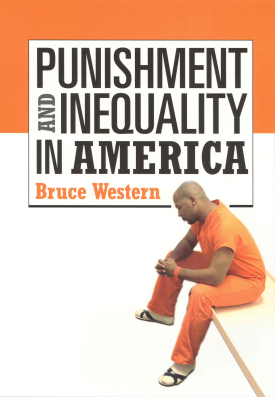
Punishment and Inequality in America
About This Book
Winner of the 2008 Michael J. Hindelang Book Award from the American Society of Criminology
Winner of the 2007 Albert J. Reiss, Jr. Distinguished Scholarship Award
Over the last thirty years, the prison population in the United States has increased more than seven-fold to over two million people, including vastly disproportionate numbers of minorities and people with little education. For some racial and educational groups, incarceration has become a depressingly regular experience, and prison culture and influence pervade their communities. Almost 60 percent of black male high school drop-outs in their early thirties have spent time in prison. In Punishment and Inequality in America, sociologist Bruce Western explores the recent era of mass incarceration and the serious social and economic consequences it has wrought.
Punishment and Inequality in America dispels many of the myths about the relationships among crime, imprisonment, and inequality. While many people support the increase in incarceration because of recent reductions in crime, Western shows that the decrease in crime rates in the 1990s was mostly fueled by growth in city police forces and the pacification of the drug trade. Getting “tough on crime” with longer sentences only explains about 10 percent of the fall in crime, but has come at a significant cost. Punishment and Inequality in America reveals a strong relationship between incarceration and severely dampened economic prospects for former inmates. Western finds that because of their involvement in the penal system, young black men hardly benefited from the economic boom of the 1990s. Those who spent time in prison had much lower wages and employment rates than did similar men without criminal records. The losses from mass incarceration spread to the social sphere as well, leaving one out of ten young black children with a father behind bars by the end of the 1990s, thereby helping perpetuate the damaging cycle of broken families, poverty, and crime.
The recent explosion of imprisonment is exacting heavy costs on American society and exacerbating inequality. Whereas college or the military were once the formative institutions in young men’s lives, prison has increasingly usurped that role in many communities. Punishment and Inequality in America profiles how the growth in incarceration came about and the toll it is taking on the social and economic fabric of many American communities.
BRUCE WESTERN is professor of sociology at Princeton University.
Related Events & Media
RSF Journal
View Book Series
Sign Up For Our Mailing List
Apply For Funding
Pagination
- Previous page
- Page 55
- Next page
